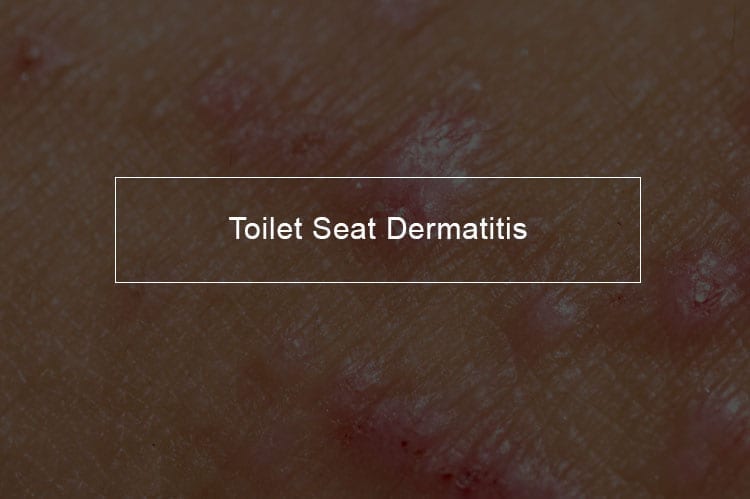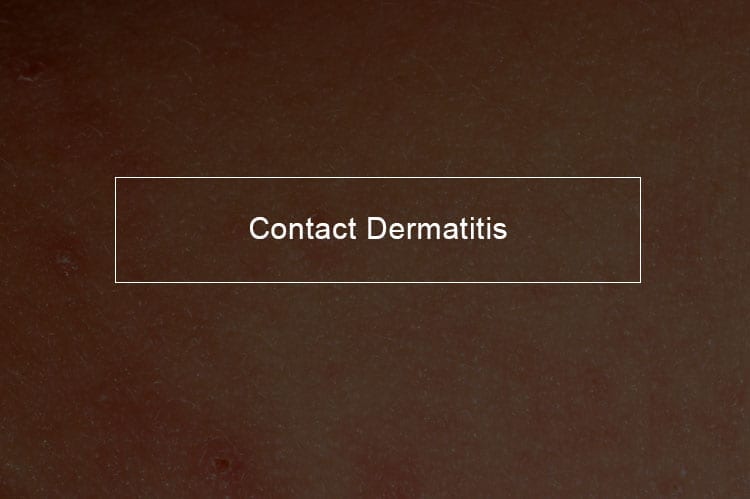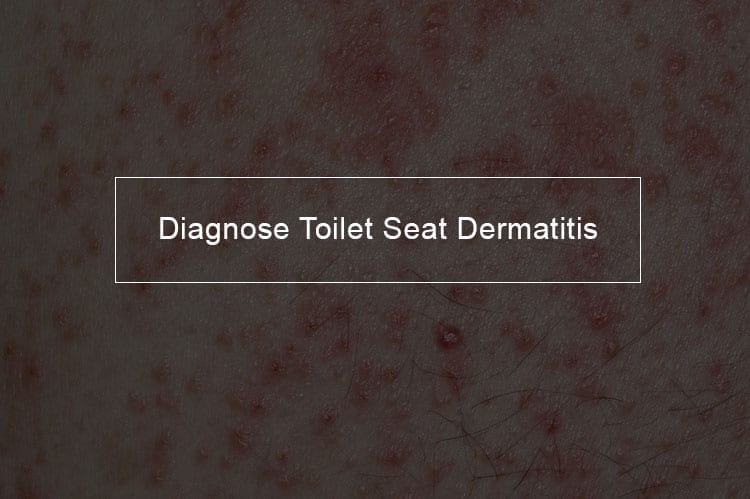
Toilet seat dermatitis is a condition which causes skin irritation around the buttocks and upper thighs and can lead to painful and itchy skin eruptions if not dealt with. In the early 20th-century toilet seat dermatitis, a condition which causes skin irritation around the buttocks and upper thighs and can lead to painful and itchy skin eruptions if not dealt with was not uncommon and correlated with the varnish, lacquer, and paints used on wooden toilet seats.
When most homeowners switched to plastic toilet seats, the condition declined dramatically, but a new study reported in Pediatrics suggests that the complications are once more on the increase partially due to the renewed popularity of wooden seats but also; because of, harsh chemical cleaners used on toilet seats in public washrooms.In two of the instances described in the research, the children's toilet seat dermatitis had been as a result of their school’s use of chemical cleaners, containing components such as didecyl dimethyl ammonium chloride and Benzalkonium chloride, which have previously been recorded to result in severe skin irritation.The individuals carrying out the research suggested the use of plastic toilet seats in the home and toilet seat covers in public places.
How Common is Allergic Toilet Dermatitis?
Understanding Allergic Toilet Dermatitis
Toilet-seat contact dermatitis is a common condition around the world and is re emerging in the United States. It can be easily recognized and treated. However, few practitioners consider this diagnosis, which results in a delay in treatment and often worsening of the skin eruption. In the past, exposure to wooden toilet seats and associated paints, lacquers, and varnish led to the development of allergic contact dermatitis on the buttocks and posterior thighs.
In recent years, most public facilities have changed to plastic seats, resulting in a change in the clinical presentation of toilet-seat dermatitis. Among 5 cases of toilet-seat dermatitis in children from the United States and India and review the history, display, and clinical course of the disease. The findings suggest that toilet-seat dermatitis is more common than previously recognized and we should look out for in any child with dermatitis that involves the posterior thighs and buttocks.
What is Toilet Seat Dermatitis And How Can I Avoid It?
How Do I Prevent Toilet Seat Dermatitis?
A team of pediatricians suggests that a disease not seen for a long time in America, toilet seat dermatitis, where skin irritations form on the posterior thighs and buttocks from contact with toilet seats, could be making a comeback.
Toilet seat dermatitis is one of those well-known complications described in medical textbooks and seen in underdeveloped regions, but one that younger pediatricians have not come across in their everyday practice. In case our small analysis is any representation of what's on the ground, we need to ensure the condition is on every pediatrician's radar. Toilet seat dermatitis developed due to exposure to wooden toilet seats and associated varnish, lacquers, and paints. It led to allergic contact dermatitis to form on the posterior thighs and buttocks.They suggest the occurrence of the condition could be down to the same culprits, due to wooden seats, particularly those covered with paints and varnishes, appear to be getting more popular as "exotic" bathroom décor; another reason, however, might be harsh cleaning chemicals.
This complication is conspicuous, and its treatment can occur through topical steroids. However, few practitioners consider this diagnosis, leading to delayed treatment and often an exasperation of the skin eruption which goes all over and results in painful itching and needless misery for affected infants and their parents and guardians. Persistently irritated skin is prone to bacteria and may result in more severe infections forcing you to take oral antibiotics. Delayed diagnoses were a benchmark of all 5 cases described.Some of the children in the study suffered for years before researchers were through with the correct diagnosis.
Ways You can Avoid Allergic Toilet Dermatitis
The researchers said you could avoid toilet seat dermatitis by:
- Put paper toilet seat covers in public washrooms, including school and hospital toilets.
- Taking out wooden toilet seats and replacing them with plastic ones
- Cleaning toilet bowls and places each day
- Not using harsh store-brand cleaners, which usually have skin irritants like formaldehyde or phenol.
- Using hydrogen peroxide and rubbing alcohol instead, since these are still effective but not as harsh on the skin surface
- Cohen said children could start showing signs of irritation after several uses of a wooden seat or one that has been cleaned using harsh chemicals.
Medical practitioners urge guardians and parents to inquire about the use of and cleaners toilet seats at home and school when they see an infant or toddler with irritated skin around the upper thighs or buttocks.
What Leads to Allergic Toilet Dermatitis?
Cause of Allergic Toilet Dermatitis?
Poison sumac, poison ivy, and poison oak are the most common causes of allergic contact dermatitis. Detergents used in public washrooms and in hospitals consistently score higher in irritation potential than detergents used at home. Many reports have documented that alkaline detergents are more likely to cause skin irritation than acidic detergents because they perturb the body’s natural acidic environment.11,12 pH factor are suspected to be a contributory cause of toilet-seat dermatitis. Other common reasons that doctors observe in clinical practice include:
- Antibiotic creams
- Rubber
- Nickel allergy (typically seen in jewelry wearers)
- Cosmetics
- Chemicals
Surprisingly, laundry detergents are not a common reason for allergic toilet dermatitis.
Common Symptoms of Contact Dermatitis

How Do I Know If I Have Contact Dermatitis?
In irritant toilet dermatitis, the symptoms experienced will be according to how irritating the trigger agent is. If they are mild irritants, you may only see tiny amounts of redness, small skin cracks, dry skin, and itching.In case the irritants are harsh, you’re likely to witness or inflammation, blistering, pain, and oozing of the affected part.
Symptoms of allergic toilet dermatitis are quite similar. Most often, there is a raised rash that is often fiercely itchy. The affected region usually is where the substance made contact with your skin surface but can spread to other parts of the body on your hands. It's why it is essential to wash your hands thoroughly if you know that you've come in contact with a substance that causes allergic toilet dermatitis for you.
Diagnosis of Toilet Dermatitis?

Patch testing For Toilet Dermatitis
Your doctor may be able to diagnose toilet dermatitis and identify its cause by interacting with you about every sign and symptom you have, questioning you to uncover clues about the trigger element, and examining your skin to note the pattern and intensity of your rash.
Your dermatologist may suggest a patch experiment to see if you develop an allergic reaction to certain substances. This test can be beneficial in case the cause of your rash isn't evident or if your rash continually recurs.When a patch test is underway, the doctor will spread small amounts of potential allergens to adhesive patches, which then goes on your skin. The spots remain on your skin surface for about three days, during which you'll need to maintain a dry skin.Your doctor then checks for skin reactions under the patches and determines whether further testing is needed.
How Can I treat Toilet Dermatitis?
Toilet Dermatitis Treatment
If you know what caused the contact dermatitis, do not touch or get in contact with it again. Clean your skin with mild soap and cool water immediately, if you can. You may eliminate all or most of the problem substance. That could assist reduce and relieve the symptoms. When the rash covers only a small region, hydrocortisone cream may be all you require for relief. For blisters, apply a cold, moist compress for 30 minutes, three times a day. In case your skin is damaged, put moisturizer on it several times a day to help restore the protective layer. Oral antihistamines can help relieve itching. Do not use an antihistamine lotion unless your doctor suggests it because it could cause skin irritation or an allergic reaction, too.
When to See Your Doctor?
Call your doctor or health provider if your rash is painful or concerns you, or if it isn't better after a couple of days. Your doctor will take a look and ask you questions to help figure out what's going on. Depending on how severe it is, he may prescribe steroid pills or ointment, and an antihistamine. Your doctor can do skin tests to determine what you are allergic to.
If you can not avoid what's bothering your skin, talk to your doctor about wearing gloves or using creams to keep it safe. In case home care procedures don't ease your symptoms, your doctor may prescribe medications. Examples are:
- Steroid ointments or creams. These topically applied creams or lotions assist in soothing the rash of toilet dermatitis. A topical steroid may be used once or twice each day for two to four weeks.
- Oral medications. In severe instances, your doctor may recommend oral corticosteroids to minimize inflammation, antihistamines to relieve itching or antibiotics to fight a bacterial infection.
Lifestyle and home remedies For Toilet Dermatitis?
DIY Solutions For Toilet Dermatitis
To assist in soothing inflamed skin and reducing itching, try these self-care steps:Stay away from the allergen or irritant. The secret to this is identifying what leads to your rash and avoiding it like the plague. Your dermatologist may give you a list of products that typically contain the element that affects you. Also, ask for a list of products that are free of the aspect that concerns you.
In case your skin has an allergic reaction to the metal in jewelry, you can still put it on by putting a barrier between your skin surface and the metal. For instance, place the inside of a bracelet in line with a piece of clear tape or use clear nail polish to paint over the accessory.
Spread an anti-itch lotion or cream to the affected region. A nonprescription cream that has a minimum of 1 % hydrocortisone can temporarily relieve your itch. Apply steroid ointment once or twice a day for about two to four weeks; alternatively, you can try calamine lotion.
Swallow oral anti-itch medicine. Antihistamine or a nonprescription oral corticosteroid, for example, diphenhydramine (Benadryl), may be beneficial if your itching is severe.Spread cool, wet compresses. Moisten soft washcloths and press them gently against the skin rashes to soothe your skin for about 20 minutes. Go through this procedure a number of times with the day.
Stay away from scratching the rashes. Cut your nails. In case you can't resist scratching an itchy section, wrap it up with dressing. Sink in a cooling bath and let it soak. Sprinkle the water with an oatmeal-based bath product or baking soda.
Protect your hands by washing and drying your hands well and gently after rinsing. Use moisturizers throughout the day. And choose gloves according to the reason you're protecting your hands. For instance, plastic gloves lined with cotton are excellent if your hands are often wet.
Conclusions: Toilet-seat dermatitis continues to be a common condition in children and adults around the world. This condition can arise after exposure to plastic or wooden toilet seats. Inappropriate diagnosis of ringworm, unrelated allergy, or other dermatoses may cause a delay in proper treatment or more frequent washing, resulting in aggravation of dermatitis. Even though it is often difficult to discern the toilet seat dermatitis, it responds well to the described treatment. Pediatric practitioners should consider this disease for any child or adult who presents with itchy dermatitis on his or her buttocks and posterior thighs. It is important to underscore that regular use of toilet-seat covers is the key to success in treatment. Such seat covers can be purchased at any major retailers such as Wal-Mart or on-line. As an alternative, newspaper cut-outs could be used to provide barrier protection. Although it is possible to develop an allergy to toilet-seat covers, none have been reported thus far in the article.




